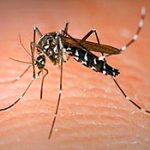The Asian tiger mosquito or forest day mosquito is characterized by its black and white striped legs, and small black and white striped body. It is native to the tropical and subtropical areas of Southeast Asia; however, in the past couple of decades this species has invaded many countries throughout the world through the transport of goods and increasing international travel. This mosquito has become a significant pest in many communities because it closely associates with humans (rather than living in wetlands), and typically flies and feeds in the daytime in addition to at dusk and dawn. The insect is called a tiger mosquito because its striped appearance is similar to a tiger.
Like other mosquito species, only the females require a blood meal to develop their eggs. Apart from that, they feed on nectar and other sweet plant juices just as the males do. In regards to host location, carbon dioxide and organic substances produced from the host, humidity, and optical recognition play important roles.
The search for a host takes place in two phases. First, the mosquito exhibits a nonspecific searching behavior until it perceives host stimulants, wherupon it secondly takes a targeted approach.[16] For catching tiger mosquitoes with special traps, carbon dioxide and a combination of chemicals that naturally occur in human skin (fatty acids, ammonia, and lactic acid) are the most attractive.
The Asian tiger mosquito particularly bites in forests during the day and has been known as the forest day mosquito for this very reason. Depending upon region and biotype, there are differing active peaks, but for the most part they rest during the morning and night hours. They search for their hosts inside and outside of human dwellings, but are particularly active outside. The size of the blood meal depends upon the size of the mosquito, but it is usually around 2 microlitres.
It also bites other mammals besides humans and they also bite birds. They are always on the search for a host and are both persistent and cautious when it comes to their blood meal and host location. Their blood meal is often broken off short without enough blood ingested for the development of their eggs. This is why Asian tiger mosquitoes bite multiple hosts during their development cycle of the egg, making them particularly efficient at transmitting diseases. The mannerism of biting diverse host species enables the Asian tiger mosquito to be a potential bridge vector for certain pathogens, for example, the West Nile virus that can jump species boundaries.

